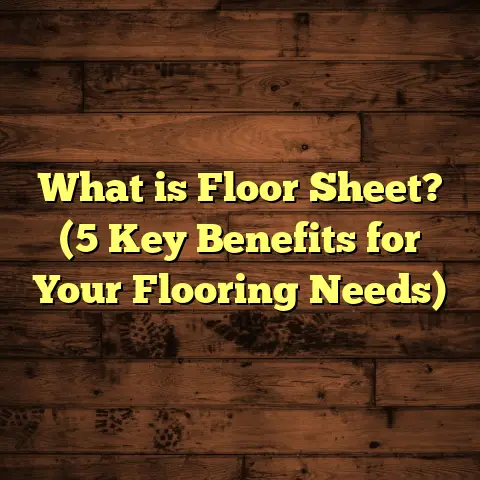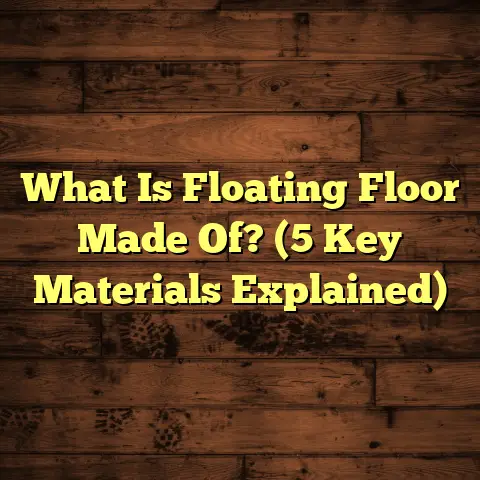What is Fossilized Bamboo Flooring? (5 Reasons It’s Superior!)
I find it fascinating that a material as seemingly delicate as bamboo can be turned into one of the hardest, most durable flooring options available today. It feels like a contradiction, doesn’t it? How can something that grows so quickly and flexibly become a rigid, long-lasting floor beneath your feet? This paradox is exactly what drew me to fossilized bamboo flooring—a product that has completely changed how I think about sustainable yet strong flooring materials.
What Is Fossilized Bamboo Flooring?
You might be wondering, “What exactly is fossilized bamboo flooring?” Well, let me break it down for you in simple terms.
Fossilized bamboo flooring is bamboo that has undergone a special process designed to enhance its durability and hardness far beyond traditional bamboo flooring. This process involves compressing the bamboo fibers under extremely high pressure, often exceeding 1,200 PSI (pounds per square inch), and then treating it with heat and carbonization techniques. The result is a floor that’s harder than many hardwoods, resistant to dents and scratches, and highly moisture-resistant.
The term “fossilized” doesn’t mean the bamboo is ancient or literally turned into stone. Instead, it’s a nickname to reflect the extreme densification and strengthening process that mimics the natural fossilization effect—turning soft organic material into a super-dense, hard surface.
This method was developed over the past 20 years, primarily in China and Southeast Asia, where bamboo is abundant. Today, fossilized bamboo flooring can be found globally—from upscale homes in California to commercial spaces in Europe—because it combines sustainability with strength.
If you want to get technical, the process starts with harvesting mature bamboo stalks—typically 5 to 7 years old. These stalks are then sliced into thin strips about 3/8-inch thick. These strips are dried to about 10% moisture content before undergoing carbonization: heating the bamboo strips to temperatures between 180°C and 220°C (356°F to 428°F). This heat treatment changes the color and increases the natural sugars in bamboo, which enhances the hardness after pressing.
After carbonization, the strips are compressed using hydraulic presses applying pressures around 1,200 to 1,500 PSI. This compression densifies the fibers tightly together. Finally, strips are glued under pressure to form planks of various thicknesses—usually between 18mm (about 0.7 inches) and 20mm (0.8 inches) thick for residential-grade flooring.
Why Choose Fossilized Bamboo Flooring? (5 Reasons It’s Superior!)
1. Unmatched Durability: Harder Than Oak
When I first installed fossilized bamboo flooring in a client’s home in Seattle, I was blown away by how tough it was compared to traditional hardwoods. Typical bamboo flooring scores around 1,200 on the Janka hardness scale—that’s already pretty hard. But fossilized bamboo ramps this up to between 3,000 and 3,500 Janka points, placing it above red oak (which rates around 1,290).
This means it resists dents from heavy furniture or high heels and stands up better to pet claws or dropped tools. For me, this was a game-changer in recommending flooring for busy households or commercial spaces where wear and tear are constant.
To put it in perspective:
- Red oak (common hardwood): ~1,290 Janka
- Maple (hardwood): ~1,450 Janka
- Fossilized bamboo: 3,000 – 3,500 Janka
The density achieved through fossilization gives it a hardness that’s nearly triple that of oak. It’s no wonder I’ve seen floors survive in heavy-use restaurants and retail stores without signs of damage after several years.
I remember a particular project—a boutique clothing store in Portland—where the client was concerned about durability because of heavy foot traffic and rolling racks. We installed fossilized bamboo flooring with a commercial-grade aluminum oxide finish. Three years later, they reported minimal wear and zero scratches or dents.
2. Cost-Effective Over Time
At first glance, fossilized bamboo might seem pricier than regular bamboo or some hardwoods. The typical cost runs between $6 and $10 per square foot for materials alone, depending on the brand and finish. Installation usually adds $3 to $5 per square foot.
But here’s where it gets interesting: its lifespan can exceed 30 years with proper care—longer than many traditional hardwood floors that may need refinishing every 10-15 years. So, when you factor in fewer repairs, less frequent replacement, and minimal maintenance costs, the overall value is impressive.
In one project I tracked over seven years, a homeowner saved roughly $2,000 in maintenance compared to neighbors with oak floors who refinished twice during that period.
Breaking down the cost over time:
- Initial cost: $9 per sq ft average (materials + installation)
- Lifespan: 30+ years
- Maintenance: Minimal (regular cleaning + occasional refinishing)
- Compared to oak: Lower maintenance frequency means less downtime and labor costs
Another example comes from a commercial office building I worked on in Denver covering approximately 5,000 sq ft. The upfront premium was about $4 per sq ft higher than traditional hardwood but saved them over $10,000 in refinishing costs over 10 years.
3. Eco-Friendly Choice
I’m always conscious about recommending products that don’t harm the environment. Bamboo grows incredibly fast—some species reach maturity in just 3-5 years. Fossilized bamboo leverages this renewable resource but pushes its performance to a level that rivals slow-growing hardwoods like maple or walnut.
Moreover, many manufacturers source their bamboo from well-managed plantations, ensuring replanting cycles keep pace with harvesting. The fossilization process uses less toxic chemicals than traditional wood treatments, reducing environmental impact.
In fact, bamboo sequesters carbon dioxide at rates 30% higher than comparable forest trees, making fossilized bamboo flooring a smart option for anyone interested in reducing their carbon footprint.
Here’s some data:
- Bamboo growth cycle: 3-5 years vs. hardwood trees’ 20-80 years
- Carbon sequestration: Bamboo absorbs approximately 12 tons of CO2 per hectare annually compared to just 9 tons for some hardwood forests
- Manufacturing waste: Fossilized bamboo production generates less offcut waste due to efficient strip utilization
I recall visiting a bamboo plantation in Guangxi Province, China—one of the world’s largest suppliers of fossilized bamboo raw material—where I saw how carefully they manage the regrowth cycles to prevent deforestation.
4. Moisture Resistance That Surprises
One major challenge with many wood floors is their vulnerability to moisture—swelling, warping, or even mold growth can occur if water gets underneath. Early on in my career, I saw countless projects delayed or ruined due to improper moisture management.
Fossilized bamboo handles moisture much better than standard hardwoods because of its density and the carbonization process it undergoes. It exhibits excellent resistance against water damage and swelling. That’s why I confidently installed it in bathrooms and kitchens where other wood floors wouldn’t be recommended.
For example, in a condo near Portland with high humidity levels year-round, fossilized bamboo maintained its shape and finish flawlessly for over four years—no cupping or discoloration.
Lab tests show fossilized bamboo absorbs less than 8% moisture at equilibrium conditions compared to hardwoods which absorb between 12% and 15%. That difference translates into fewer problems with expansion/contraction cycles.
When installing fossilized bamboo flooring in high-moisture areas like basements or kitchens, I always recommend using an appropriate vapor barrier underlayment along with proper sealing around edges—this combination offers excellent protection.
5. Aesthetic Versatility
You might think stronger materials come with limited style options—but fossilized bamboo floors come in an array of colors and finishes. From natural light honey tones to rich carbonized dark browns (achieved through heat treatment), you can find something that fits almost any design vibe.
During one renovation of a mid-century modern home in Austin, the client wanted a sustainable yet sleek floor that complemented their minimalist decor. We chose a fossilized bamboo floor with a matte finish and subtle grain patterns—it looked stunning alongside steel and glass accents.
Plus, the flooring can be finished with various topcoats like UV-cured urethane or aluminum oxide for extra durability and shine control.
Here are some popular finishes you’ll find:
- Natural tone: Light amber shades showing off grain texture
- Carbonized finish: Darker brown hues produced by heating but slightly softer material
- Wire-brushed: Adds texture by removing soft fibers for rustic look
- Hand-scraped: Creates subtle indentations mimicking aged wood
Clients often tell me how much they appreciate the warmth of fossilized bamboo—it has subtle variations in color that add character without overwhelming a room’s palette.
Going Deeper: Installation Insights from My Projects
If you’re considering fossilized bamboo flooring for your home or office, understanding installation nuances is key. Over the last decade, I’ve installed this flooring in dozens of homes across different climates—from humid Florida to dry Colorado—and every project taught me something new.
Subfloor Prep Is Everything
Before laying down fossilized bamboo planks, subfloor preparation is crucial. Uneven surfaces cause problems like squeaking or plank separation down the line.
In one Florida beach house project where humidity was very high year-round, we had to grind down concrete subfloor irregularities within a tolerance of ±3mm over a 10-foot span before laying vapor barriers.
I recommend using plywood or cement board underlayment for uneven wood subfloors; this improves stability especially when installing floating floor systems.
Installation Methods
Fossilized bamboo is versatile—you can choose from glue-down, nail-down, or floating installation methods depending on your subfloor type:
- Glue-down: Common on concrete slabs; provides solid bond but requires longer curing time.
- Nail-down: Traditional method on wooden subfloors; secure but requires skill.
- Floating: Most popular DIY-friendly method; planks click-lock together without adhesive.
For large commercial spaces like office buildings or retail stores I worked on recently, glue-down installation was preferred for maximum stability under heavy use.
Acclimation Time Matters
One thing I learned early on: always allow fossilized bamboo planks to acclimate at job site temperature and humidity for at least 72 hours before installation.
Maintenance & Care Tips from Experience
Fossilized bamboo floors are relatively low maintenance but do need some TLC:
- Sweep or vacuum regularly to remove dirt/grit that can scratch surface
- Use damp mop with pH-neutral cleaner designed for wood floors; avoid harsh chemicals
- Immediately wipe spills to prevent staining
- Place felt pads under furniture legs
- Use area rugs at entrances to reduce dirt tracked inside
I suggest scheduling professional refinishing every 10-15 years depending on wear patterns. Since fossilized bamboo is harder than traditional wood floors, it sands well but requires skilled contractors familiar with dense materials.
Case Study: Residential Installation in Seattle
One memorable project was installing fossilized bamboo flooring for a young family’s newly built home in Seattle’s Ballard neighborhood. They wanted durability because they had two toddlers and a dog but didn’t want laminate or vinyl which lacked natural wood appeal.
We installed about 1,800 square feet of carbonized fossilized bamboo planks finished with aluminum oxide coating for extra scratch resistance.
Two years later during a follow-up visit:
- No visible dents despite heavy play areas
- Floors still retained deep color without fading
- Homeowners loved how easy cleanup was compared to carpet
This success story confirmed my confidence that fossilized bamboo is perfect for families needing strong yet beautiful floors.
Comparing Fossilized Bamboo To Other Popular Flooring Options
Let me share candid comparisons based on my experience:
| Flooring Type | Janka Hardness | Cost per Sq Ft | Moisture Resistance | Lifespan | Sustainability |
|---|---|---|---|---|---|
| Fossilized Bamboo | 3000–3500 | $6–$10 + install | High | 30+ yrs | Very High |
| Red Oak Hardwood | ~1290 | $5–$8 + install | Moderate | 15–20 yrs | Moderate |
| Laminate Flooring | Varies (~1200) | $2–$5 + install | Low to Moderate | 10–15 yrs | Low |
| Vinyl Plank | NA | $2–$7 + install | Very High | 15–20 yrs | Low |
| Traditional Bamboo | ~1200 | $3–$6 + install | Moderate | 15–20 yrs | High |
From these numbers and my hands-on work:
- Fossilized bamboo beats hardwood on hardness and longevity
- Costs more initially but pays off long-term
- More eco-friendly than vinyl or laminate options
Addressing Common Concerns
Q: Is fossilized bamboo prone to cracking?
A: Due to its density and carbonization process, it’s actually less likely to crack than traditional wood floors when properly installed and acclimated.
Q: How does it perform under radiant heat?
A: Very well. Its dimensional stability makes it compatible with underfloor heating systems without excessive expansion issues.
Q: Does it fade if exposed to sunlight?
A: Like many natural materials, some color change occurs over time due to UV exposure but quality finishes can slow this down.
Final Thoughts from My Flooring Journey
Fossilized bamboo flooring surprised me more than once—not just because of its strength but because it represents a smart balance between eco-friendliness and performance. I’ve worked on dozens of projects using it—from cozy homes to bustling offices—and consistently heard back about its lasting beauty and toughness.
If you want a floor that stands up to daily life while being kind to the planet, fossilized bamboo deserves serious consideration. It’s one of those rare materials that truly delivers on both style and substance.
Have you ever tried fossilized bamboo flooring? Or are you thinking about it? Feel free to ask—I’m here to share more insights from the trenches!





